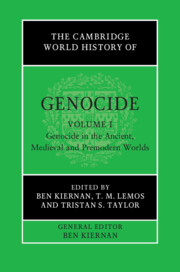Book contents
- The Cambridge World History of Genocide
- The Cambridge World History of Genocide
- The Cambridge World History of Genocide
- Copyright page
- Contents
- Figures
- Maps
- Tables
- Contributors to Volume I
- General Editor’s Acknowledgements
- General Editor’s Introduction to the Series
- Introduction to Volume I
- Part I Themes of Genocide through History
- Part II The Ancient World
- Part III The Medieval World and Early Imperial Expansions
- 15 William the Conqueror’s Harrying of the North, 1069–1070
- 16 Genocidal Massacres of Jews in Medieval Western Europe, 1096–1392
- 17 Crusaders and Mass Killing at Jerusalem in 1099
- 18 The Albigensian Crusade and the Early Inquisitions into Heretical Depravity, 1208–1246
- 19 Mongol Genocides of the Thirteenth Century
- 20 Việt Nam and the Genocide of Champa, 1470–1509
- 21 Genocidal Massacres in Medieval India
- 22 Mass Extermination in Prehistoric Andean South America
- 23 The Spanish Destruction of the Canary Islands
- 24 Genocidal Massacres in the Spanish Conquest of the Americas
- Index
17 - Crusaders and Mass Killing at Jerusalem in 1099
from Part III - The Medieval World and Early Imperial Expansions
Published online by Cambridge University Press: 23 June 2023
- The Cambridge World History of Genocide
- The Cambridge World History of Genocide
- The Cambridge World History of Genocide
- Copyright page
- Contents
- Figures
- Maps
- Tables
- Contributors to Volume I
- General Editor’s Acknowledgements
- General Editor’s Introduction to the Series
- Introduction to Volume I
- Part I Themes of Genocide through History
- Part II The Ancient World
- Part III The Medieval World and Early Imperial Expansions
- 15 William the Conqueror’s Harrying of the North, 1069–1070
- 16 Genocidal Massacres of Jews in Medieval Western Europe, 1096–1392
- 17 Crusaders and Mass Killing at Jerusalem in 1099
- 18 The Albigensian Crusade and the Early Inquisitions into Heretical Depravity, 1208–1246
- 19 Mongol Genocides of the Thirteenth Century
- 20 Việt Nam and the Genocide of Champa, 1470–1509
- 21 Genocidal Massacres in Medieval India
- 22 Mass Extermination in Prehistoric Andean South America
- 23 The Spanish Destruction of the Canary Islands
- 24 Genocidal Massacres in the Spanish Conquest of the Americas
- Index
Summary
Crusading in the Levant remains one of the notorious chapters in medieval history. Though rich in source material and featuring an expansive historiography, the violence of the subject has seldom received attention as a discrete topic. This study limits the analysis to the First Crusade and specifically to events at Jerusalem in July 1099. Consulting Western, Armenian, Arabic and Hebrew sources reveals the nature and perception of this eleventh-century event. Crucial considerations include: pre-existing contextual tumult in the Levant, questions around crusader extermination policy, source material reliability, and if crusade violence was exceptional. Within a century, the fall of Jerusalem became a tool in the service of political agendas. This created mythistory that served to illuminate as well as obfuscate and influenced subsequent scholarship. The central question persists: Did genocide occur at Jerusalem? The sources agree that violence, bloodshed and mass killing characterize the crusader victory. The research concludes that it is not necessary to think or argue that the crusades were in fact genocide, but underscores what we might learn from looking at the violence of the crusades through the paradigm of genocide studies.
Keywords
- Type
- Chapter
- Information
- The Cambridge World History of Genocide , pp. 448 - 469Publisher: Cambridge University PressPrint publication year: 2023

